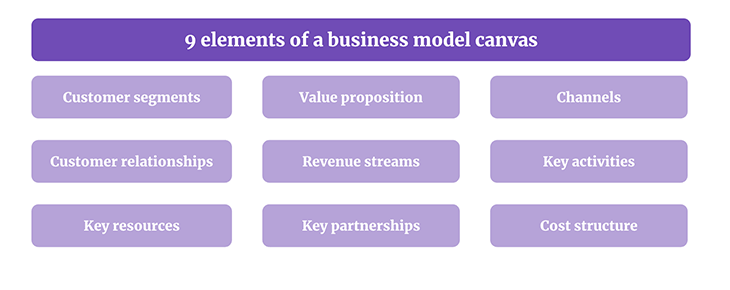In 2013, I co-founded a startup in the Indian online gifting industry with three friends. It was my first involvement with a startup. Startups are fascinating — they’re small, agile, and quick. However, another key feature of startups is their ability to creatively solve problems.

At that time, we aimed to target India’s gifting market, which was more than 90 percent offline. We had plans to establish an online shop selling a wide variety of gifts. But before we got started, we decided to document our idea. Amidst many templates, we discovered the business model canvas, a lean tool for outlining business models. It was neat, straightforward, and free. This tool brought remarkable clarity to our idea.
Despite shutting down the startup in 2015, I gained a wealth of knowledge during those two years. One major takeaway was the tools and techniques I learned along the way. The business model canvas was one of them. Even after seven years, I still use the business model canvas in my role as a product manager.
In this blog post, we’ll explore how product managers and entrepreneurs can effectively use a business model canvas.
The business model canvas is a template introduced by Alexander Osterwalder in 2005 as part of his Ph.D. studies under the supervision of Yves Pigneur. The business model canvas outlines nine crucial elements of a business model in an easy-to-understand visual template: customer segments, value proposition, channels, customer relationships, revenue streams, key activities, key resources, key partnerships, and cost structure.
Various companies, including startups, scale-ups, and large software organizations, have utilized this template since its inception to simplify their business strategy and improve their understanding of the overall business structure. However, before we delve into what a business model canvas entails, it’s important to comprehend why simplifying business strategy and structure is essential.
The last company I was part of employed 10,000 individuals. It ran more than 20 different businesses, each generating millions in revenue. When operating on such a large scale, it’s vital to have a clear strategy that outlines the business models. This strategy should define who the customers are, identify key partners, elaborate on the value proposition, and explain the cost structure, among other things.
The strategic blueprint serves as a go-to source of information whenever confusion arises. While this is true for large corporations, it’s equally applicable to smaller scale-ups and startups. It’s crucial to understand the business strategy and models from the onset. This comprehension aids in crafting a framework that can be applied when tackling complex issues or determining priorities.
This is where the business model canvas proves invaluable. It assists in laying out business models in a straightforward, user-friendly format.
The business model canvas comprises nine key elements:

These components cover the three main areas of a business: desirability, viability, and feasibility. The nine components also aim to bring transparency and understanding to a broad audience, which can include upper management and internal teams such as engineering, design, product management, marketing, sales, legal, and customer service.
Collectively, these elements capture the essence of a business model. They help map the relationship between these elements and how they intertwine with one another. Let’s take a more in-depth look at each element.
Everything starts with the customers, which is why this is the first element of the business model canvas. This component identifies the different customer segments a company targets. These can vary across business models.
For example, while working at Zalando (one of Europe’s largest fashion eCommerce companies), there were multiple business models. One focused on end customers, while another focused on partners selling products on Zalando. The business model canvas helps outline these customer segments in a single snapshot.
Try to avoid being too detailed. Mention who the partners are, but there’s no need to note the demographics, age, gender, etc., of the customer segment unless required.
This term refers to the unique advantage or value a business provides. It’s what sets the business apart from competitors. This could be a product or a service that the business uses to solve a customer’s problem.
For instance, Uber’s value proposition is its ability to help customers travel from point A to point B on demand.
Channels are the various ways through which a business intends to interact with customers and/or partners. For Airbnb, their website and apps are the primary channels. But they also leverage social media, offline hoardings, email marketing, and community forums to reach their audience.
This element addresses the various ways a business interacts with customers to improve satisfaction and the overall experience. Monitoring customer feedback and how they interact with a company’s product is critical in a competitive landscape.
Amazon, a company that prioritizes customer focus, includes 24/7 customer support, personalized recommendations, regular newsletters, ratings and reviews, Amazon Prime membership, and community engagement as part of its customer relationships.
This component lists the different ways a company plans to generate revenue. For Google, revenue streams include advertising, the Google Play Store, Google Cloud, and hardware sales.
This section includes all necessary activities needed to keep the business functioning smoothly and to deliver value to all users. Microsoft’s key activities, for example, include software development, hardware development, cloud computing, gaming, research and development, and VR.
As the name implies, key resources are the essential tangible and intangible resources needed to keep the business operational. These resources incur costs, making their documentation vital. An online gift-selling company would require a website/app, collaborations with manufacturers, and marketing capabilities.
This element focuses on the partnerships or collaborations a business might have with other companies to better serve customers, reduce risks, and increase profits. For Facebook, key partners include regular users who generate content, advertisers, and influencers who create content at scale.
This element outlines the costs and expenses associated with a business. For companies like Google and Facebook, costs can be substantial given their value propositions. While it may be difficult to capture the cost structure of these giants in a small space, it becomes easier and beneficial for smaller companies.
For example, McDonald’s cost structure would include manufacturing costs, service-based costs (such as employee costs), franchise costs, and infrastructure costs.
Indeed, using a business model canvas offers many advantages for businesses of all sizes. To summarize, some of the key benefits include:

A business model canvas provides a visual overview of all the critical elements of a business. This allows stakeholders to see how these elements relate to each other, facilitating understanding and decision-making.
The visual nature of the canvas makes it accessible to various stakeholders, including top management, engineers, designers, customer service, and operations teams.
Developing and managing products often require the input and collaboration of multiple stakeholders. A business model canvas provides a clear, concise tool for aligning all these parties, promoting better communication and collaboration. It also helps product managers secure buy-in from stakeholders at an early stage, reducing risks and fostering better alignment, especially in a cross-functional environment.
By design, a business model canvas encourages long-term strategic thinking. It helps identify business strengths and weaknesses, facilitates brainstorming new ideas and improvements, and shapes long-term strategies to better serve customers.
Businesses and ideas evolve, and a business model canvas accommodates these changes. It offers a flexible template that can be easily modified, often featuring version numbers to track document evolution. This flexibility supports an iterative approach, ensuring the canvas captures all necessary information as the business evolves.
The internet is replete with various business model templates. A quick Google search will return 34,200,000 results. Here’s a quick template that I created on Google Sheets:

Click here to access the business model canvas template. You can click File > Make a copy to download the canvas and customize it for your business.
Here’s an example of a business model canvas for Facebook:

After you fill out the nine components we went over earlier, there are some other key points to keep in mind to successfully create a business canvas model.
Since a business model canvas has elements ranging from tech to marketing, sales, and customer service, it’s important to involve these stakeholders right at the start. This reduces the risk and helps to bring everyone on the same page.
Don’t use complex sentences while explaining the pointers under every element. Use simple and short words. Simplicity will make it easier for the audience to consume the information effectively.
Let every pointer included in the business model canvas be data-driven. This will help lay down a strong foundation for long-term decision-making.
It’s difficult to come up with a business model canvas right at the first go. Hence, it’s important to keep an iterative approach and let the document evolve depending on the feedback from the contributors. You can use versioning to keep track of all the changes.
Currently, the growth of many businesses is slow and it’s projected to be the same for the entire year. It’s important to consider these external factors while coming up with a business model canvas since it helps to consider factors that might not be in control of a business.
A business model canvas can be a very effective tool if used right away. Product managers can use this tool before starting a product or a feature. It can help them have clarity on the idea before the actual development work starts.
Also, since it involves all the major stakeholders right at the start, a business model canvas can help mitigate risks early on. It’s a great tool for validating business ideas, products, or a feature.
Featured image source: IconScout
LogRocket identifies friction points in the user experience so you can make informed decisions about product and design changes that must happen to hit your goals.
With LogRocket, you can understand the scope of the issues affecting your product and prioritize the changes that need to be made. LogRocket simplifies workflows by allowing Engineering, Product, UX, and Design teams to work from the same data as you, eliminating any confusion about what needs to be done.
Get your teams on the same page — try LogRocket today.

Red-teaming reveals how AI fails at scale. Learn to embed adversarial testing into your sprints before your product becomes a headline.

Cory Bishop talks about the role of human-centered design and empathy in Bubble’s no-code AI development product.

Learn how to reduce mobile friction, boost UX, and drive engagement with practical, data-driven strategies for product managers.

Jim Naylor shares he views documentation as a company’s IP and how his teams should use it as a source of truth.